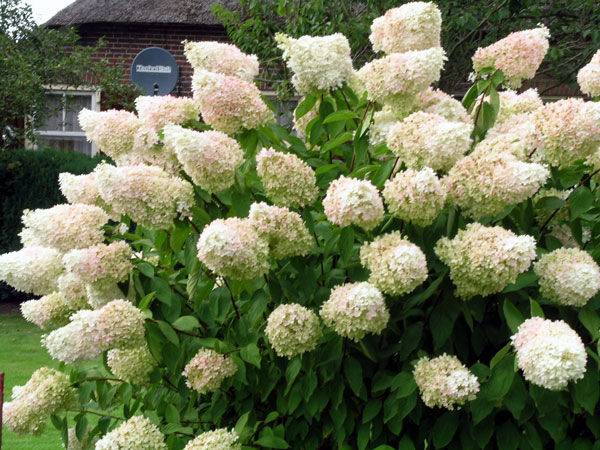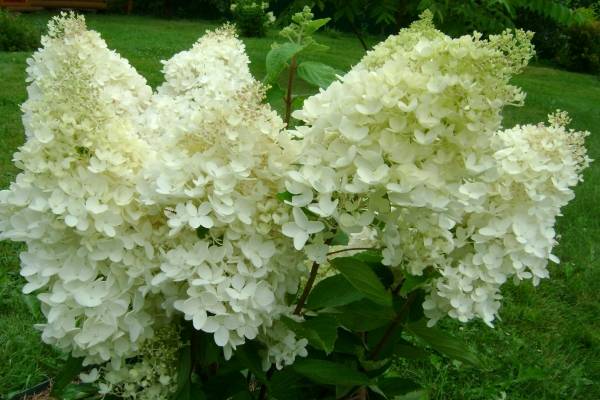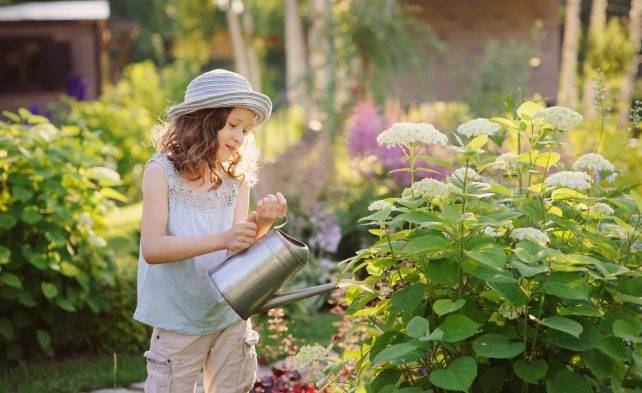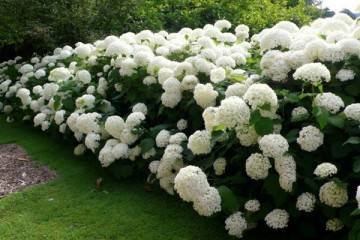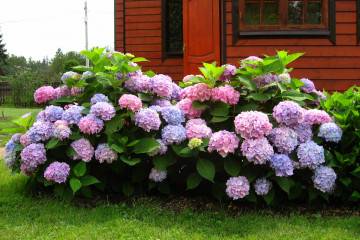Hydrangea Grandiflora - description, planting and care in the open field
Content:
Hydrangea Grandiflora is the most spectacular shrub with decorative flowering. It is actively used in landscape design to decorate summer cottages, parks, alleys. For a culture to flourish, it needs to be cared for properly.
Description of hydrangea Grandiflora and its characteristics
Hydrangea paniculata Grandiflora is considered a very popular crop. It has beautiful inflorescences and high frost resistance, so it is grown by many growers.
History of origin
This crop is considered an old variety, which was obtained in East Asia in 1860. In those days, the Hydrangea Paniculata bushes could reach 10 m. Modern plants are more modest in size.
Features of the variety
According to the description, the panicle hydrangea Grandiflora is a deciduous shrub that grows up to 2 m in height. In diameter, it can reach 3 m. Inflorescences include small flowers. They have a pyramidal shape. The inflorescences can be up to 30 cm long. The flowers are generally sterile and do not form fruit.
At first, the inflorescences have a creamy shade, and then they turn white and even pinkish. By autumn, the hydrangea takes on a green-red hue. Bloom lasts from June to September. The leaves have an elongated shape and reach a length of 12 cm. From below they are covered with fluff.
Winter hardiness
The plant is considered surprisingly hardy. Thanks to this, it can be grown in the northern regions. Bushes can tolerate temperatures as low as -30 ° C.
Planting and further care
Planting and caring for the hydrangea tree-like Grandiflora in the open field has certain characteristics.
Site selection and preparation
The culture is considered a light-loving plant. However, for planting, it is worth choosing a place with diffused lighting. Intense sun can burn out foliage and flowers. The soil should be of medium acidity.
How to plant
The flower can be planted in spring or fall. When planting several plants, it is important to observe an interval of 2-2.5 m.To plant the Paniculat Grandiflora hydrangea, it is worth doing the following:
- Prepare a 50 cm depression.
- Pour soil into the hole.
- Remove the seedling from the container and place it in the center of the hole.
- Sprinkle with soil.
- Tamp the earth and pour water over it.
Watering and feeding
The plant is drought tolerant, but it needs to be watered frequently to flourish. Once a week, it is worth pouring 1.5-2 buckets of water under the bush. This should be done in the morning or evening. In the heat, the amount of watering is increased up to 2-3 times a week.
In order for the hydrangea tree-like Grandiflora to fully develop, it must be constantly fed.In the spring, it is recommended to use organic matter - a solution of mullein or bird droppings. At the initial stage of bud formation, a composition of superphosphate, ammonium nitrate and potassium salt is used.
In the summer, it is recommended to add a combined remedy for flowering crops. In the fall, a mixture of superphosphate and potassium salt should be used. It helps the plant survive the winter.
Pruning
Hydrangea is constantly growing, while there is a risk of damage to the flowers. With a strong thickening of the culture, their number decreases, the inflorescences become smaller. Pruning can stimulate the formation of new branches and flowers. The lashes need to be cut into 2-3 buds.
Preparing for winter
Despite its high frost resistance, when growing hydrangeas in a harsh climate, it must be insulated. To do this, the trunk circle is mulched with dry leaves and sawdust. The upper part of the bush should be covered with a thick cloth.
Reproduction
It is recommended to propagate hydrangea by vegetative methods:
- dividing the bush. The procedure should be performed in spring or autumn. To do this, a fragment of the shoot with the root must be separated from the mother culture and planted in a new place;
- by cuttings. When carrying out the procedure, you need to cut off the upper parts of the shoots and plant in a shady place. Cover the top with a glass jar. Bushes need to be watered and ventilated periodically. When the roots appear, they can be transplanted to a permanent place;
- layering. In this case, the lower shoots should be cleaned of leaves, placed in prepared furrows, sprinkled with soil and watered. Once the roots have formed, the shoot can be dug up and transplanted.
Diseases and pests: means of combating them
The plant can suffer from powdery mildew. It is accompanied by the appearance of a white bloom. At the initial stage of the development of the disease, it is enough to rinse the bush with water. If this does not help, fungicides and insecticides are used.
Of the parasites, hydrangea most often suffers from leaf aphids. It absorbs the juices of the plant, which leads to the dropping of the buds. Actellik will help to cope with parasites. Also, the plant can suffer from spider mite attacks. For prevention, the culture can be sprayed with garlic infusion.
Use in landscape design
Hydrangea is often used to decorate gardens. She can play the role of a rich accent. With the help of a flower, you can decorate fences or various structures.
The culture is often planted in parks, combined with birches, lilacs, maples. A great combination can be obtained with roses and dahlias. Also, the flower looks good with thuja.
Hydrangea Grandiflora is very popular among flower growers. This crop has a spectacular appearance and is distinguished by long flowering. The indisputable advantage of the plant is its unpretentiousness in care. Due to this, it is often used in landscape design to decorate parks, gardens, alleys.
